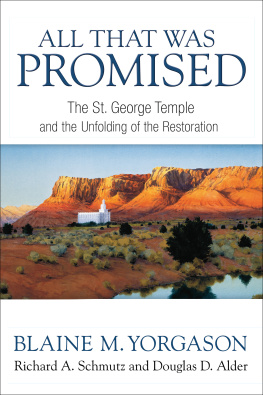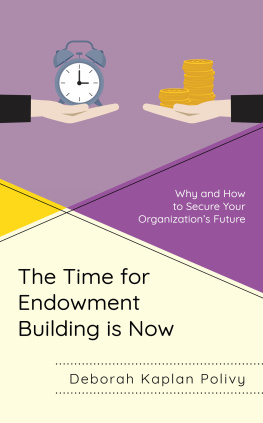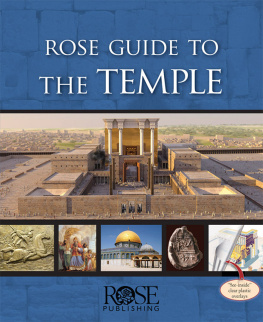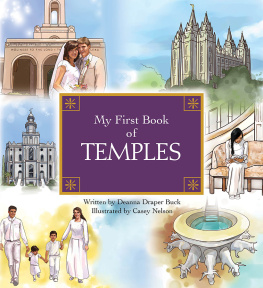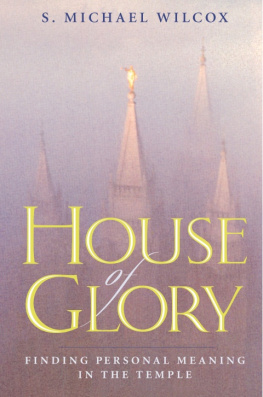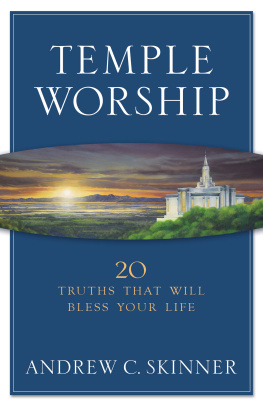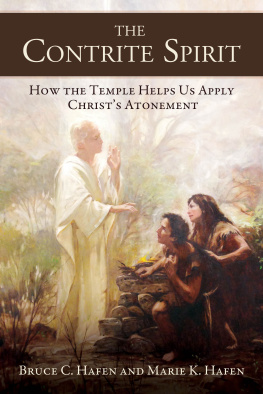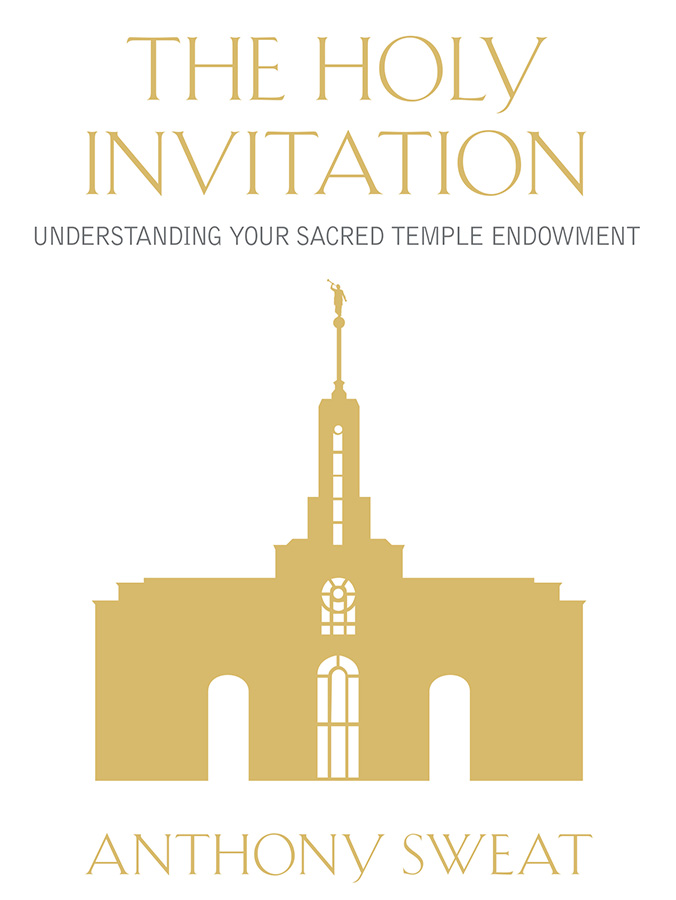Introduction
Learning about the Endowment
The sacred ordinances of the holy temple are the pinnacle of everything we do in The Church of Jesus Christ of Latter-day Saints. Everything. Children sing in Primary that they love to see the temple. Young women recite their motto, proclaiming their aim to receive the ordinances of the temple for exaltation. Members are encouraged to prominently hang a picture of the temple in their homes.
The temple and its ordinances were also the pinnacle of Joseph Smiths revelatory teachings and prophetic career. From his first revelation that ever mentioned the concept of endowment in 1831 to his capstone teachings in the Nauvoo Red Brick Store presented to the Apostles and women of the Relief Society, Joseph desired the members of the Church to be endowed with power from on high (D&C 38:38). Today his prophetic vision is unfolding. There are more temples on earth, in more places, available to more members, than ever before in the earths history. Coupled with that, due to the lowering of the missionary age requirements for young women and young men, people are receiving the endowment ordinances at a younger age than ever beforemany just out of high school. These are exciting times.
Exciting times, however, also bring challenging times. As the temple endowment is given to more people at a younger age, some feel they are underprepared or cant seem to grasp the meanings of these sacred, summative ordinances. Some enter the temple without ever having taken a temple preparation class. Some receive their endowment with the mentality of crossing off a to-do from their mission or marriage checklist. Some want to understand the temple endowment but struggle to find anyone or anything that can give them straightforward, appropriate, in-depth answers as to the purposes and procedures of its ordinances. Sadly, some walk away from the temple bewildered and confused, even hurt, due to the unfamiliar nature of the presentation of the endowment. They want the endowment to be straightforward and plain, like modern church or school classes, when the Lords approach in the temple is to use different, higher ways to lift learners to heaven and open their minds to revelation (see Isaiah 55:89). Due to their lack of understanding or confusion, sadly, some hesitantly or never return to the house of the Lord. This, simply, should not be.
This Books Purpose
The aim of this small book, then, is to give a soon-to-be or newly endowed young woman or young man, or perhaps a recently reactivated or newly converted adult, a big-picture perspective of the endowment ordinances. As the books title implies, it is an invitationa beginning or commencement of your entrance into the house of the Lord. For a few reasons, I purposely do not attempt to address everything related to the endowment. One reason is that there is simply too much to learn, and I dont pretend to have it all figured out. I find myself consistently learning new things in my temple worship, and I expect to continue to do so throughout my whole lifeand thats thrilling. President David O. McKay, as the prophet of the Church and near the end of his life, said to some of his fellow Apostles that he was finally beginning to understand the temple endowment ordinances. If an aged prophet with a lifetime of experience says that, there is no way that I or anyone else can capture everything about the endowment in one book. Its like trying to bottle up an oceanthe endowment is eternally too big and deep. What I can do, however, is introduce you to some main concepts. What I can do is provide you some lenses that may give helpful perspective. What I can do is put things together in a way that I hope makes the endowment more understandable and accessible. This book aims to give you increased vision, for where there is no vision, the people perish (Proverbs 29:18).
This Books Organization
To help provide a clearer vision, I have organized this book into three distinct sectionsaddressing the what , the why , and the how to help you see the endowment in different ways. Part 1 of this book introduces a historical and doctrinal definition of endowment, primarily through the lens of Church history and the Doctrine and Covenants. Why the Doctrine and Covenants, you may ask? Isnt the Old Testament the best place to learn about the temple, as we are commonly told? Surely there are excellent things to learn about the nature and purposes of the temple in all scriptures. But in the pages of the Doctrine and Covenants we see the Lord restore large concepts related to the endowment in small revelatory doses as Joseph Smith progressed through his prophetic ministryhere a little and there a little, bit by bit, dot by dot. In connecting these revelatory dots, a grand image of the overall purpose of the endowment appears with depth and beauty.
Using the lens of storytelling, Part 2 introduces why the endowment process is so meaningful through a metaphor called The Commoner and the King. Although this story is based on some historical realities (like bathing before meeting royalty, or a servant knocking on the door to the kings chamber), it is a fictional account given to aid in learning and not to be interpreted as an actual source of the temple endowment.
Following the discussion of the what and why , Part 3 explores how you can accept the holy invitation the Lord has extended to you individually, introducing a spiritual learning pattern to help you seek divine knowledge, be influenced by Gods Spirit, and make personal application through your worship in the endowment. Using a teaching method similar to that of the temple itself, this book combines history, metaphor, scripture, and personal participation to help you comprehend eternal truths on your own. While providing perspective, I deliberately have not put all the dots together for you. For example, I dont interpret the parable of the Commoner and the King. That would rob you of half the joy! It will be much more meaningful and memorable for you to make specific connections yourself.
This Books Sources
One difficulty with teaching and learning about the temple endowment is that a few specific aspects should not be discussed outside of the temple. Thus, due to that sacred nature, many are hesitant to talk about the endowment at all. This seems to be a mistake, however, and may unnecessarily contribute to people being underprepared for the endowment ceremonies. Think how confused new members would be if we never discussed the meanings and messages of baptism! Our deep reverence for these sacred ordinances shouldnt translate into complete silence. President Howard W. Hunter invited members to teach more earnestly and more comfortably the things we can appropriately say about the purposes of the house of the Lord. In this book I try to follow that example and use published teachings of the Church, Joseph Smith, and the scriptures to more openly explain what endowment means in hopes that you will be more prepared and informed to meaningfully participate in the endowment ordinances.
This Books Invitation
Throughout this book, one concept I refer to often is the summary definition of endowment as the power and capacity to enter the presence of God. In these pages youll learn some amazing history and doctrine related to this idea. As you read, however, you may wonder: Does this definition of endowment mean that I should literally expect to see God in the temple or in my lifetime, or that Im doing something wrong if I dont? Perhaps a quick story can give some perspective so we dont misunderstand this point.






